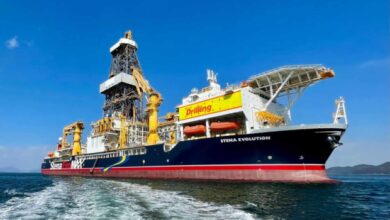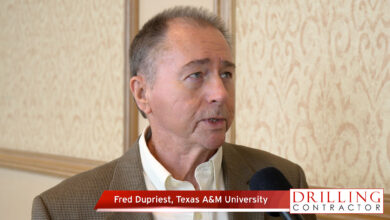Controlled mud level system finds extension from drilling to cementing
If the CML MPD system is already being used to drill a difficult well, applying it during cementing can help to prevent losses, improve efficiency
By Linda Hsieh, Editor & Publisher; and Sarah Junek, Associate Editor
As the adoption of Enhanced Drilling’s EC-Drill system increases, managed pressure cementing (MPC) applications have become a natural extension of the system’s capabilities. The technology – a variant of managed pressure drilling (MPD) called controlled mud level (CML) – involves placing a subsea pump on the rig’s marine riser. The pump allows the fluid level in the riser to be adjusted by controlling the speed of the pump as it returns mud and cuttings up a separate mud return line, which is directed to the rig’s mud-processing system.
“That means we can perform MPD and well optimization without having any restrictions in the riser. It’s a tool for the entire drilling process,” said Per Christian Stenshorne, VP of Product Line for Enhanced Drilling.
Because the kind of wells that use this technology are generally difficult wells to begin with, using the system while cementing has also proven valuable in many cases, Mr Stenshorne said. For example, it can allow for extension of casing strings and successful cementing of casing strings in difficult wells. “For the cementing technology providers, the use of EC-Drill opens the margins for performing cementing operations,” he explained.

Simply put, MPC operations help to prevent losses by reducing the annular pressure to compensate for the increase in hydrostatic pressure in the annulus as cement and spacers are displaced into the annulus. “Because of the system’s simplicity and its ability to place wellbore pressures within the available drilling window, it’s easy to also use it either to cement wells that you otherwise couldn’t or to use it as a risk mitigation tool during more conventional cement jobs,” he added.
One challenge that operators often face during cementing is verifying that the cement was properly placed. “Our system adds a return flow meter, which can then be used when evaluating the jobs to have documented evidence that there were no losses during the job,” said Dave Smith, Sales Manager for the Americas with Enhanced Drilling. “That, combined with the final displacement pressure of the cement, generally gives you strong evidence in the integrity of the cement job.”
Enhanced Drilling also believes that use of its system can improve the efficiency of cement jobs. “On many cementing operations, particularly deeper liners, the casing annulus is very narrow,” Mr Smith said. Friction pressure in the annulus may lead to increases in the bottomhole pressure, forcing slower cement displacement rates that can lead to poor mud displacement and contamination between the mud and cement. “We use the system to compensate for friction pressure so we can achieve a higher flow rate during displacement of the cement job – even using the same conventional cement slurries and spacers,” Mr Smith said. “Just by compensating for that friction, it can allow for higher pump rates without losses so the cement is better displaced.”
In 2017, MPC was deployed in the Barents Sea offshore Norway. Cementing simulations were predicting losses in a zone drilled with 1.20 SG mud and a 1.33 SG fracture gradient during a production liner cementation. The operator opted to use EC-Drill, which allowed conventional cement to also be used. By reducing the fluid level in the annulus before the operation, the fracture pressure margin was increased. As the cement filled the annulus, the fluid level was further reduced. Annular pressure was precisely controlled through changes in the pump rate and riser level.
In total, the operator performed 11 casing and liner cementing jobs and set 10 kick-off and abandonment plugs in six wells using this system.
Enhanced Drilling also provides drilling and MPC capabilities for top-hole sections. “We help the operator get surface casing strings deeper and address formations that are difficult to drill in the shallow section,” Mr Smith said, adding that operators continue to challenge the company to compensate for higher and higher levels of pressure so they can push the top holes deeper.
MPC in the top hole is typically done in combination with the company’s Riserless Mud Recovery (RMR) system. This closed-loop, dual-gradient drilling system allows for mud and cuttings to be returned to the rig before the marine riser is run and without discharge to the seabed. “It also provides volume control, allowing accurate monitoring of gains and losses from the well,” Mr Smith said.
Being able to verify cement integrity in this section is critical, Mr Stenshorne added. “Everything you do rests on having a very good cement job for the conductor. This is where the BOP, and later the Christmas tree, is mounted. To have that cement job well done is extremely important.” The company recently added new sensors in several parts of the system, including the return flow meter, “so we can document that we did not have losses or that they were minor during the cement job.”
The company is also working to integrate the hardware kits for EC-Drill and RMR so the same setup can be used across the entire well construction process, starting from the top hole. “That’s something customers have requested that we are responding to,” Mr Stenshorne said.
Back in 2015 and early 2016, EC-Drill was used on a few wells in the Gulf of Mexico, but work has been limited to Norway since then. However, as the market picks back up, interest is renewing in the Gulf of Mexico. Enhanced Drilling is scheduled to return to this market in 2020, working for Shell in the Perdido area. MPC is expected to be part of the work scope. DC






